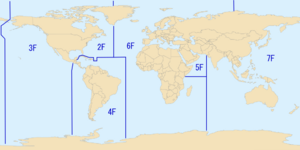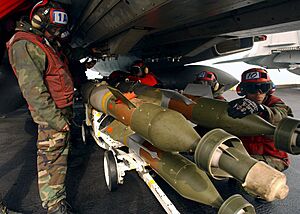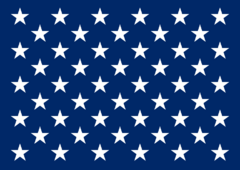United States Navy facts for kids
Quick facts for kids United States Navy |
|
|---|---|
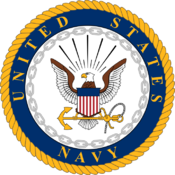
Emblem of the United States Navy
|
|
| Founded | 27 March 1794 (231 years, 9 months) (in current form) 13 October 1775 |
| Country | |
| Type | Navy |
| Role | Naval warfare |
| Size | |
| Part of | Armed forces of the United States Department of the Navy |
| Headquarters | The Pentagon Arlington County, Virginia, U.S. |
| Motto(s) | Semper Fortis ('Always Courageous'), (unofficial). Non sibi sed patriae ('Not for self but for country') (unofficial) |
| Colors | Blue and gold |
| March | "Anchors Aweigh" |
| Anniversaries | 13 October |
| Equipment | List of equipment of the United States Navy |
| Engagements |
See list
American Revolutionary War
American–Algerian War (1785–1795) Quasi-War First Barbary War War of 1812 Second Barbary War West Indies Anti-Piracy Operations Seminole Wars African Anti-Slavery Operations Aegean Sea Anti-Piracy Operations First Sumatran expedition United States exploration expedition Patriot War Second Sumatran expedition Ivory Coast Expedition Capture of Monterey Mexican–American War Bombardment of Greytown Battle of Ty-ho Bay First Fiji Expedition Filibuster War Second Opium War Third Fiji expedition Reform War Paraguay expedition American Civil War Bombardment of Qui Nhon Shimonoseki Campaign Formosa Expedition United States expedition to Korea Egyptian Expedition (1882) Bering Sea Anti-Poaching Operations Kingdom of Hawaii overthrowal Second Samoan Civil War Banana Wars
Philippine–American War
1989 air battle near Tobruk
Bosnian War
Iraq War |
| Commanders | |
| Commander-in-Chief | |
| Secretary of Defense | |
| Secretary of the Navy | |
| Chief of Naval Operations | |
| Vice Chief of Naval Operations | |
| Master Chief Petty Officer of the Navy | |
| Insignia | |
| Flag |  |
| Ensign |  |
| Jack |  |
| Pennant | |
| Logo |  |
The United States Navy (USN) is one of the biggest and strongest navies in the world. It is a very important part of the U.S. military. The Navy helps protect America's interests all over the world.
It is the most powerful navy in the world. It also has the largest fleet of aircraft carriers. These huge ships can hold up to 5,000 people. That's like a small town floating on the ocean!
The U.S. Navy is the third largest branch of the U.S. military. This is based on the number of people who serve in it.
As of 2018, the Navy uses over 460 ships. It also has more than 3,650 aircraft. The Navy owns 75,200 buildings across 3.3 million acres of land.
Contents
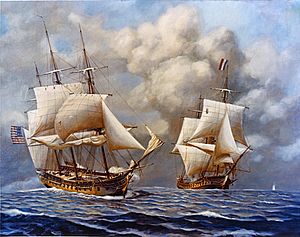
The U.S. Navy started in 1775 during the American Revolutionary War. After the war ended in 1783, the Navy was stopped. Many private ships went back to being merchant ships.
But soon, America needed a navy again for international trade. The War Department was created in 1789. It handled naval matters at first.
In 1798, the Department of the Navy was created. This was a new government department just for the Navy. Benjamin Stoddert was the first leader of this department. He led the Navy during the "Quasi-War" with France. This was an undeclared naval war from 1798 to 1800.
The Marines also started in 1775. They were reactivated in 1798 as part of the new Navy Department.
The Navy gained experience in several conflicts. These included the Algerian War (1815) in 1815. They also fought pirates in the West Indies from 1816 to 1829. The Navy helped stop slavery from 1820 to 1850. All this training helped them in the Mexican–American War from 1846 to 1848.
In 1854, the Naval Academy was founded. This helped train officers to be more professional. The Navy also explored new technologies like steam engines. They sponsored important trips, like the Pacific expedition from 1838 to 1842.
The U.S. Navy played a key role in World War II. They helped defeat Imperial Japan. After World War II, the U.S. Navy became the most powerful navy in the world. Today, it still has a large presence globally. You can find U.S. Navy ships in the Pacific Ocean, the Mediterranean Sea, and the Indian Ocean.
The U.S. Navy has many important jobs. These include:
- Anti-surface warfare (ASuW): Fighting against enemy ships.
- Anti-submarine warfare (ASW): Finding and fighting enemy submarines.
- Anti-air warfare (AAW): Defending against enemy aircraft.
- Land attack: Striking targets on land from the sea.
- Littoral warfare: Operating close to coastlines.
- Naval gunfire support: Using ship guns to help ground troops.
- Mine warfare: Using or clearing naval mines.
- Amphibious warfare: Landing troops and equipment from sea to land.
- Naval Special Warfare: Special operations carried out by elite teams like the Navy SEALs.
The modern U.S. Navy uses several types of ships and vessels:
- Aircraft carriers: These are huge ships that act like floating airports. They can launch and land planes for many different missions. The Nimitz-class and Gerald R. Ford-class carriers are some of the largest warships ever built.
- Submarines: These quiet ships are important for scouting and fighting other submarines. They can also be used for strategic defense. Nuclear-powered submarines can stay underwater for a very long time.
- Destroyers and cruisers: These ships protect aircraft carriers and other vessels. They can fight against air, submarine, and surface threats.
- Amphibious assault ships: These ships carry Marines and their gear. They help quickly move forces from the sea to the land.
The U.S. Navy is part of the Department of the Navy. The United States Marine Corps is also part of this department. The Department of the Navy is led by a civilian called the Secretary of the Navy.
The Department of the Navy is part of the larger Department of Defense. The Department of Defense is led by the Secretary of Defense. The highest-ranking Navy officer in the Department of the Navy is the Chief of Naval Operations (CNO).
The U.S. Navy has several main operating forces. These include:
- United States Fleet Forces Command (formerly the Atlantic Fleet)
- United States Pacific Fleet
- United States Naval Forces Central Command
- United States Naval Forces Europe
- Naval Network Warfare Command
- Navy Reserve
- United States Naval Special Warfare Command
- Operational Test and Evaluation Force
The Fleet Forces Command also controls other important groups. These include the Military Sealift Command and the Naval Expeditionary Combat Command.

The U.S. Navy has over 400,000 people serving. About a quarter of them are in the ready reserve. Most active duty personnel are enlisted sailors. About 15% are commissioned officers. The rest are students at the United States Naval Academy or other training programs.
New sailors start with basic military training at boot camp. After that, they go on to specialized training for their specific jobs.
Sailors earn "warfare qualifications" by proving their skills. These qualifications show they are experts in areas like Surface Warfare or Submarine Warfare. Many of these achievements are shown on a sailor's uniform with special badges and insignia.
U.S. Navy uniforms have changed over time. The first rules for officer uniforms came out in 1802. The main colors of Navy uniforms are navy blue and white. U.S. Navy uniforms were often similar to those of the British Royal Navy.
Navy officers can be either a line officer or a staff corps officer. Line officers wear a gold star above their rank. Staff corps officers wear special symbols that show their job.
| Type | Line officer | Medical Corps | Dental Corps | Nurse Corps | Medical Service Corps | Judge Advocate General's Corps |
|---|---|---|---|---|---|---|
| Insignia |  |
 |
||||
| Designator1 | 1XXX | 210X | 220X | 290X | 230X | 250X |
| Chaplain Corps (Christian Faith) |
Chaplain Corps (Jewish Faith) |
Chaplain Corps (Muslim Faith) |
Chaplain Corps (Buddhist Faith) |
Supply Corps | Civil Engineer Corps | Law Community (Limited Duty Officer) |
 |
 |
|||||
| 410X | 410X | 410X | 410X | 310X | 510X | 655X |
Insignia and badges are special symbols. The Navy gives them to service members who earn certain skills. These badges are worn on uniforms. Many naval aviation badges can also be worn on Marine Corps uniforms.
Here are a few examples of Navy badges:
The U.S. Navy mainly uses missiles as weapons. They also use them to defend against threats. Besides missiles, the Navy uses different types of torpedoes. These include the Mark 46, Mark 48, and Mark 50 torpedoes. They also use various naval mines.
The Navy's nuclear weapons are carried by ballistic missile submarines and aircraft.
The current naval jack of the United States is called the Union Jack. It is a small blue flag with the stars of the 50 states.
Famous Sailors
Many important people in U.S. history have served in the Navy.
Some famous Navy officers include:
- John Paul Jones
- John Barry (the first flag officer of the U.S. Navy)
- James Lawrence (famous for his last words, "don't give up the ship")
- Commodore Matthew C. Perry (who helped open Japan to trade)
- George Dewey (the only person to reach the rank of Admiral of the Navy)
- Chester W. Nimitz
- William F. Halsey Jr.
Presidents Who Served
Several U.S. Presidents served in the Navy:
- John F. Kennedy (who commanded the famous PT-109 in World War II)
- Lyndon B. Johnson
- Richard Nixon
- Gerald Ford
- Jimmy Carter
- George H. W. Bush
Other Notable People
Many other well-known people were in the Navy. These include:
- Astronauts: Neil Armstrong (the first person on the moon), Alan B. Shepard, John Young, and Scott Kelly.
- Entertainers: Johnny Carson, Paul Newman, Humphrey Bogart, Jack Lemmon, and Henry Fonda.
- Authors: Robert Heinlein and Marcus Luttrell.
- Musicians: John Philip Sousa and John Coltrane.
- Athletes: David Robinson, Roger Staubach, and Yogi Berra.
- Computer Scientists: Grace Hopper.
Images for kids
-
USS Constitution vs HMS Guerriere during the War of 1812
-
A carte de visite of a U.S. Navy lieutenant during the Civil War
-
Navy SEALs at an entrance to the Zhawar Kili cave complex
-
USS Port Royal, a Ticonderoga-class cruiser.
-
USS Jack H. Lucas, an Arleigh Burke-class destroyer.
-
USS Constitution, firing a 17-gun salute in 2014.
See also
 In Spanish: Armada de los Estados Unidos para niños
In Spanish: Armada de los Estados Unidos para niños


